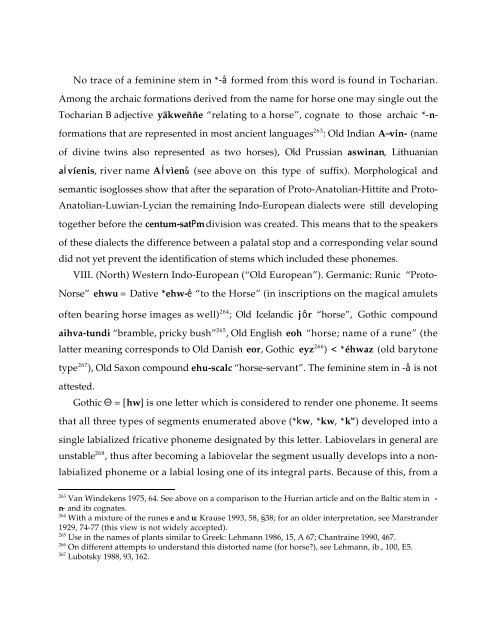Comparative Notes on Hurro-Urartian, Northern Caucasian
Comparative Notes on Hurro-Urartian, Northern Caucasian
Comparative Notes on Hurro-Urartian, Northern Caucasian
You also want an ePaper? Increase the reach of your titles
YUMPU automatically turns print PDFs into web optimized ePapers that Google loves.
No trace of a feminine stem in *-â formed from this word is found in Tocharian.<br />
Am<strong>on</strong>g the archaic formati<strong>on</strong>s derived from the name for horse <strong>on</strong>e may single out the<br />
Tocharian B adjective yäkweññe “relating to a horse”, cognate to those archaic *-n-<br />
formati<strong>on</strong>s that are represented in most ancient languages 263 : Old Indian A≈vin- (name<br />
of divine twins also represented as two horses), Old Prussian aswinan, Lithuanian<br />
aÍvíenis, river name AÍvìen& (see above <strong>on</strong> this type of suffix). Morphological and<br />
semantic isoglosses show that after the separati<strong>on</strong> of Proto-Anatolian-Hittite and Proto-<br />
Anatolian-Luwian-Lycian the remaining Indo-European dialects were still developing<br />
together before the centum-satPm divisi<strong>on</strong> was created. This means that to the speakers<br />
of these dialects the difference between a palatal stop and a corresp<strong>on</strong>ding velar sound<br />
did not yet prevent the identificati<strong>on</strong> of stems which included these ph<strong>on</strong>emes.<br />
VIII. (North) Western Indo-European (“Old European”). Germanic: Runic “Proto-<br />
Norse” ehwu = Dative *ehw-ê “to the Horse” (in inscripti<strong>on</strong>s <strong>on</strong> the magical amulets<br />
often bearing horse images as well) 264 ; Old Icelandic jôr “horse”, Gothic compound<br />
aihva-tundi “bramble, pricky bush” 265 , Old English eoh “horse; name of a rune” (the<br />
latter meaning corresp<strong>on</strong>ds to Old Danish eor, Gothic eyz 266 ) < *éhwaz (old baryt<strong>on</strong>e<br />
type 267 ), Old Sax<strong>on</strong> compound ehu-scalc “horse-servant”. The feminine stem in -â is not<br />
attested.<br />
Gothic Y = [hw] is <strong>on</strong>e letter which is c<strong>on</strong>sidered to render <strong>on</strong>e ph<strong>on</strong>eme. It seems<br />
that all three types of segments enumerated above (*´kw, *kw, *k w ) developed into a<br />
single labialized fricative ph<strong>on</strong>eme designated by this letter. Labiovelars in general are<br />
unstable 268 , thus after becoming a labiovelar the segment usually develops into a n<strong>on</strong>-<br />
labialized ph<strong>on</strong>eme or a labial losing <strong>on</strong>e of its integral parts. Because of this, from a<br />
263 Van Windekens 1975, 64. See above <strong>on</strong> a comparis<strong>on</strong> to the Hurrian article and <strong>on</strong> the Baltic stem in -<br />
n- and its cognates.<br />
264 With a mixture of the runes e and u: Krause 1993, 58, §38; for an older interpretati<strong>on</strong>, see Marstrander<br />
1929, 74-77 (this view is not widely accepted).<br />
265 Use in the names of plants similar to Greek: Lehmann 1986, 15, A 67; Chantraine 1990, 467.<br />
266 On different attempts to understand this distorted name (for horse?), see Lehmann, ib., 100, E5.<br />
267 Lubotsky 1988, 93, 162.





